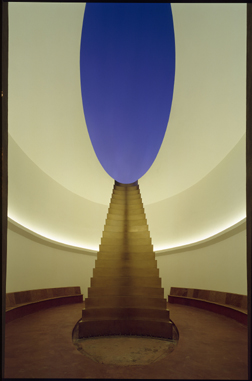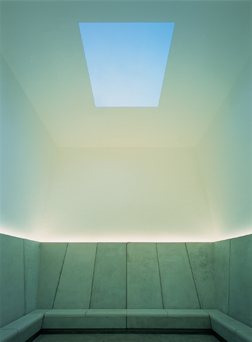
(845) 246-6944 ·
info@ArtTimesJournal.com
By
Ina Cole
ART TIMES October 2006
|
|
Turrell
is an
artist of international acclaim, who has used light and space to create
site-specific installations for over forty years. He is particularly renowned
for his skyspaces; pared down chambers of varying sizes, which are entered
by the prospective viewer. Once inside there is a feeling of oblivion
as the eyes grow accustomed to the confines of the structure, then enlightenment
as the sky is viewed as never before through an aperture in the roof.
Turrell has recently completed Deer Shelter, a permanent skyspace for
the Yorkshire Sculpture Park in the UK, and on completion, the Roden Crater,
a series of skyspaces in the Arizona Desert, will be one of the largest
works of art ever created.
Born in Los Angeles in 1943, Turrell’s early interest in the sky stems
from his father, who was an aeronautical engineer. He made a lasting impression
on the young Turrell, who consequently trained to become a pilot, before
studying mathematics and perceptual psychology, as well as art. Many of
Turrell’s projects have evolved as a result of his own pioneering research
in the late 1960s, into the changes that occur in optical and acoustic
perception under extreme conditions. Certainly, the sense of disorientation
felt once inside Turrell’s configurations is profound, as the distinction
between solid and void areas is often unclear; even after the eyes and
brain become accustomed, a sensation of altered states prevails for the
entire time spent in the structure.
The newly opened Deer Shelter at the Yorkshire Sculpture Park was originally
proposed in 1993. It is a tall, solid underground chamber excavated behind
an eighteenth-century structure, originally designed to protect the roaming
deer of that area. However, instead of a ceiling, there is a square aperture
in the roof through which visitors observe the changing sky. The aperture
has a carefully engineered rim, which, combined with the titanium-white
walls and ceiling of the chamber, have the effect of bringing the sky
closer to the human eye, seemingly transforming it into a tromp l’oeil painting. This structure was a perfect space
for Turrell to recreate; seating 36 people at a time on sculpted concrete
benches, it provides a place of quiet contemplation and revelation, without
disturbing the immediate landscape in which it is located.
Turrell has had a long interest in English skies, and Yorkshire’s brooding
landscape, which has inspired both writers and artists through time, formed
an ideal location for the Deer Shelter. Turrell travels the globe for
geographical sites renowned for a remarkable quality of light and England’s
isolated, maritime location offers extraordinarily modulated skies. On
meeting him briefly, whilst he was planning a skyspace for the distinctive
Cornish coastline, I recall his particular interest in the paintings of
JMW Turner, then displayed at the Tate Gallery’s outpost in St Ives. Clearly
the luminous, elemental forces in Turner’s paintings are at work in a
three-dimensional capacity in Turrell’s skyspaces. Even though Turrell’s
methods of creating work are extreme, the use of light and darkness in
art and architecture are linked to an enduring tradition; in painting
Constable as well as Turner are a source of inspiration to Turrell, as
are architectural feats such as light entering stained glass windows in
medieval cathedrals, and the Pantheon in Rome with an opening to the sky
from its dome.
 Roden Crater (2003) Site specific installation (interior view) Images courtesy of Yorkshire Sculpture Park., UK |
Turrell’s
magnum opus, the Roden Crater, was begun in 1974 and is still under construction.
It is an immense observatory created from an extinct volcano in the Arizona
desert and a continuation of Turrell’s experiments with light and space.
Before discovering the appropriate location for this incredible feat,
Turrell spent seven months flying across the Western states scouring the
landscape, and the 380,000 year old Roden Crater is one of over four hundred
craters in this remarkable terrain. Here, Turrell’s aim is to use light
that is there naturally; moonlight, light from the planet Venus, and even
starlight from outside the planetary system, from the galactic planes,
blended with newer light from the sun. The interior tunnels and chambers
dug into the volcanic crater are keyed into celestial events, constructed
with auditory, as well as visual responses in mind. This is certainly
an art work for the future, as Turrell’s challenge is to create the piece
so that its accuracy is keyed into events 2,000 years from now. The extraordinariness
of the Roden Crater lies both in its concept and scale; this vast construct
changes our context of vision, making the infinite palpable by isolating
pockets of sky and bringing them closer to the human eye.
The best way to view a Turrell work is without preconception; no prior
knowledge is needed, only the ability to allow the senses to become immersed
in a wave of stillness, which in an era of technological mayhem can be
a difficult state to achieve. His skyspaces rely as much on scientific
calculation as aesthetic motivation and demand complete attention. The
viewer, forced to gaze upwards, psychologically enters another dimension,
a timeless zone, where the laws of human cognition are directed inwards.
Although this can be an introspective experience, allowing oneself time
to focus the senses on the vastness of what lies above and beyond daily
existence can be a strangely liberating occurrence.
